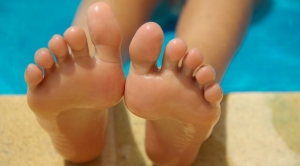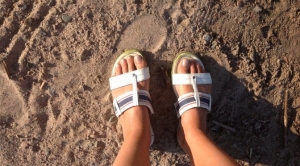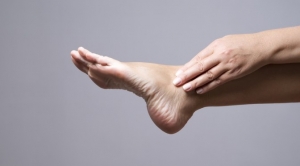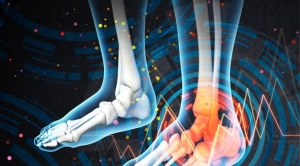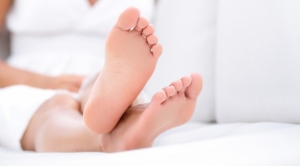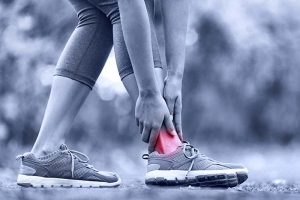Connect With Us
Blogs
Displaying items by tag: Health Tips
Building Stronger Bones
At Superior Foot & Ankle Care Center we want our Los Angeles County patients to understand the importance of strong bones for your feet and ankles. There are 26 bones in each of your feet and these bones have the important job of supporting and carrying the rest of your body. May is National Osteoporosis Month and a good opportunity for us to share some information on ways you can improve bone strength.
Partner with Your Podiatrist— Our podiatrists, Dr. Victoria M. Foley and Dr. Constance Ornelas, will help you assess your risk for osteoporosis. The foot doctor will want to know if you have a family history of osteoporosis or have had any fractures in the past. She will also ask questions about your lifestyle to help get a more complete picture of your risk for this disease. Together, you can formulate a plan to help prevent osteoporosis. It may include some or all of the following areas.
Ensure Enough Calcium and Vitamin D in Your Diet—These are the critical nutrient building blocks for strong bones. The best-known source of calcium is dairy products like milk, yogurt, and cheese. But you can also get a fair amount of calcium from leafy greens, canned sardines and salmon and certain other foods. There are also supplements as well as cereals, juices, and breads that are fortified with calcium and vitamin D.
Exercise Regularly—It’s important to have both weight-bearing and muscle-strengthening exercise as part of your fitness routine. Consider adding some exercise designed to increase balance too as this will help prevent falls which can result in fractures. If your exercise regimen has become stale, consider trying a new activity like dancing, tennis, or hiking. Join a gym, take a class or team up with a buddy and commit to a weekly fitness plan.
Make Healthy Lifestyle Choices—Several habits impact bone strength that you may not immediately identify. Smoking, excessive use of alcohol, not eating enough fruits and vegetables and being overweight can all contribute to bone weakness.
If you have concerns about the health of your bones and your feet, contact our Long Beach office at (562) 420-9800 today.
Choosing the Right Running Shoes | Superior Foot and Ankle Care Center
How to Choose the Best Running Shoe for You
Whether you’re a running novice or an experienced veteran, picking out running shoes can be a daunting task. It can be tempting to just grab the best looking pair from a popular brand, but the right shoes are imperative in preventing running-related injuries. With so many options bragging a variety of different features and claiming to help with an assortment of problems, it’s hard to know which shoes are right for you. Fortunately, there are a number of things you can keep in mind to help you make the right decision.
Shoe Buying Myths
To start, there are a number of myths surrounding running shoes. It’s important to not buy into them in order to find the best shoe for you.
There’s a Best Running Shoe
Many people choose a running shoe based on the popularity of a brand or shoe style, but everyone’s foot, running style, and needs are different. There’s no running shoe that is best for all, or even most, people. That’s why there are so many options available.
I’ve Found a Shoe I Like, so I Don’t Need to Try on Shoes Again
The same model of shoe won’t work for you forever. Models change slightly or even dramatically between years, as do your needs. Your running form can change over time due to injuries or strengthening and weakening muscles. Changes in your goals, routine, or running surface can also affect your needs. There’s also evidence that shows that alternating between different models from workout to workout can help to strengthen your ankle and foot.
The Right Shoe Will Help My Times
Your shoe won’t make you faster, but it can make you feel faster as your gait becomes more comfortable and natural. However, wear in the sole can slow you down and make you more prone to trips or falls as the shoes lose their grip. To prevent this, shoes should be replaced every 300 to 400 miles to prevent injury and ensure comfort.
Your Individual Needs
When shopping for running shoes, it’s helpful to determine your specific needs based on both the shape and size of your foot and your running style. Whenever you try on shoes, remember to bring any braces or inserts you need.
Shoe Size
When buying shoes, remember that size varies between brands and even between models within the same brand. The size you’ve worn in other shoes provide an estimate of the side you need, not a guarantee. Try on several different sizes to see what you like best. Laces should be snug and the ankle shouldn’t rub. You should have about a thumbnail’s space between your toe and the end of the box. (‘Barefoot’ style shoes are an exception. They should fit close to the toes, ‘like a glove.’) It’s helpful to try on shoes at the end of the day when they’ve swelled and are at their largest.
You should also remember that you don’t have to stick to the shoes in your gender’s section. Men with narrow feet may have luck with a women’s shoe while women with broad feet may have better luck with with a man’s shoe.
Arch Height
Like in any other shoes, having the proper support for your arch height in running shoes is important for ensuring comfort. Many running stores can help you determine your arch height, but you can also get some idea of your arch height at home using the ‘wet’ test.
Strike Location
When you foot hits the ground, it should land ankle first for the best possible form, but many people’s feet land farther forward on the foot. This can be corrected by the drop of the shoe, or the difference between the height of the toe and the height of the ankle of the shoe. A higher drop forces the foot to plant farther back.
Pronation
Pronation refers to the inward roll of the foot after the foot strikes the ground. Virtually everyone has some pronation, but there are shoes to stabilize over or under-pronation. For those who don’t need correction, minimalist or ‘barefoot’ shoes are options.
Superior Foot and Ankle Care Center
All of this information certainly provides guidance when shopping for running shoes, but what’s most important is that you find shoes that you like and makes you comfortable. If you overpronate but aren’t comfortable in any of the shoes for overpronation, not only will you be less likely to run, you may be more likely to hurt yourself, according to a 2015 study.
While finding the right shoes can be difficult, they are imperative to staying healthy while pursuing your running goals without injury. If you have difficulty finding the right pair, or suffer from a foot or ankle injury that makes running difficulty, the experts at Superior Foot and Ankle Care Center in Long Beach, California can provide you with the care and support you need to meet your goals. Contact us today to schedule an appointment and join our many satisfied customers.
How Treat and Prevent Foot Blisters
Blisters are common, especially for those who do a lot of walking or running. However, many people don’t know how to care for their blisters properly. Here are some tips for healing any blisters you may already have, and how to avoid new ones from forming:
When You Can Remove a Blister
When blisters are small and do not show any signs of infection, it is perfectly okay to pop them. Simply disinfect the area and drain before the blister can become infected. Afterward, treat the wound with antibiotic ointment.
To safely pop your blister, you should:
- Thoroughly wash your hands and the blister with water and antibacterial soap. Then cleanse the blister with rubbing alcohol or iodine.
- Gently rub your blister to see if it will pop on its own. If it doesn’t, soak your feet in warm water for 30 minutes. Then try popping it again.
- Cover the wound with antibiotic ointment and a bandage.
When You it Shouldn’t Be Remove
If your blister shows signs of redness, swelling, soreness, pus, or even pain, do not pop it. All of these symptoms may indicate that you have a serious infection, or that your blister is actually a foot ulcer. Both of these conditions require the attention of a podiatrist to be treated properly. Foot ulcers, particularly for diabetics, can become gangrenous and result in the need for amputation. If you are experiencing any of these symptoms, or if you suspect that you have a foot ulcer, seek medical attention immediately.
Blister Treatment
Blisters are often sore while they are healing, so be sure to keep your feet comfortable. For example, put extra padding on the affected area, or use a healing ointment that also provides pain relief.
Blister Prevention
In order to prevent future blisters, make sure that you always wear shoes that fit properly. In addition, avoid going sock-less while wearing shoes like sneakers or boots, particularly if you’re going to be walking for a while. When you do wear socks, be sure that they are thick and provide extra padding in sensitive area like the back of the heel. Cotton socks absorb moisture, causing blisters when the wet socks rub against your feet.
People with foot abnormalities, such as bunions, often develop blisters. If you are constantly suffering from blistering feet, consult your foot care professional.
For more foot care tips and tricks, consult the experts at Superior Foot & Ankle Care Center with all of your podiatric questions and concerns.
15 Steps to Fabulous Summer Feet
Summer can be hard on your feet, making proper foot protection a priority. Here are 15 simple steps to healthy, beautiful feet all year round:
Use Sunscreen
Protect your feet the from harsh UV rays on sunny summer days. Apply sunscreen with SPF 15 or higher to protect your skin from cancer and premature aging. Also, remember to reapply your sunscreen after swimming or sweating, even if the sunscreen claims to be waterproof.
Avoid Walking Barefoot
Walking barefoot is always dangerous, but the intense summer heat increases your risk of sustaining foot injuries. It also puts you at risk of developing plantar warts, ringworm, athlete’s foot, and other infections on the soles of your feet.
Wash Feet
Wash your feet with warm water after wading in lakes, ponds, and other stagnant bodies of water. Still water breeds bacteria, leaving you vulnerable to infection.
Treat Yourself to a Pedicure
Treating yourself to regular pedicures will ensure that both your nails and feet look their best in your chic summer styles.
Stay Hydrated
Staying properly hydrated during the hot summer months will prevent swollen feet. Proper hydration also improves your circulation, which in turn helps you fight infection.
Moisturize
Your feet are drier in the summer since you’re no longer wearing socks. Apply plenty of moisturizer in the morning after your shower to lock-in the moisture. For the best results, reapply before bed.
Wear The Right Socks
Acrylic and synthetic blend socks like CoolMax work the best to wick perspiration, preventing fungal infection. Socks that do not wick perspiration, such as those made from 100% cotton, increase your risk of developing blisters.
Prevent Blisters
Sandals can often cause blisters when they rub against bare feet. If you feel a blister developing, use extra padding such as liquid bandages to protect the affected area. If a blister does develop, be sure to treat it with antibiotic ointment after it pops.
Keep Shoes and Socks Dry
If your shoes or socks get wet, remove them. Wearing wet footwear leaves you vulnerable to developing fungal infections and blisters. Always bring a spare pair of socks and shoes if your feet could potentially get soaked.
The Right Shoes for The Right Occasion
Whether you’re going camping, hiking, boating, or running, it’s always best to wear footwear designed for the activity. Wearing improper footwear during strenuous activity can result in serious injury.
Air Out Feet
Avoid wearing closed-toe shoes and reach for sandals to let your feet breathe. If closed-toe shoes are required, be sure to take them off periodically in order to keep your feet from sweating.
Evaluate Your Flip-Flops
Flip-flops tend to cause sore feet, but that doesn’t mean that you have to avoid them. Be sure to choose flip-flops with extra padding, and avoid walking long distances in them.
Add Cushioning to Shoes.
Many summer shoes do not provide the proper cushioning to keep your feet protected and pain-free. Due to this, you should replace the cushioning in your shoes whenever possible. There are many over-the-counter insoles that will add extra cushioning on the cheap.
Inspect Old Shoes.
Old, worn-out shoes can cause blisters and other foot injuries. Be sure to assess the condition of your summer shoes, and throw away any questionable pairs.
Fore more foot care tips and inspiration, contact the experts at Superior Foot & Ankle Care Center for all of your podiatric needs.
What Causes Ingrown Toenails
Toenails that curve and dig into the skin of your toe are called ingrown toenails. Sometimes even the size of the nail are covered in skin and become embedded in the toe. This is why you should always be sure to cut your toenails straight across to discourage the sides from growing into your skin. Any toe can develop an ingrown toenail however, it is often the big toe.
While ingrown toenails are not often serious medical problems they can be severely painful. And, if left untreated and uncared for properly ingrown toenails can become infected. This is why it is important to receive proper treatment for your ingrown toenails right away.
What causes ingrown toenails?
- Shoes that are too small because they squeeze the toes.
- Toenails being cut too short.
- A toenail that has become damaged or chips can become an ingrown toenail.
- Having toes are too small to accommodate proper nail growth.
People with congenital conditions that cause them to have toenails that are frequently larger or smaller than normal should take care to always trim their nails properly and maintain proper foot hygiene because they are at high risk of developing ingrown toenails.
You may also develop ingrown toenails after sustaining a foot injury, such as a broken foot.
Other ways to keep your feet/toes healthy.
- Keep your feet clean and dry
- Keep your feet safe in public areas where they are susceptible to contracting diseases like athlete’s foot.
- Wear breathable footwear
- Don’t share footwear
- Always wear shoes that fit you properly
- If your toenails are discolored be sure to not apply any nail polish to them. Discoloration is often a sign of infection, and the Polish may make the infection worse.
Treatments
- Soak your feet
- Take over the counter pain medication
- Using a small nail file pulls the skin gently away from the nail
- Rub your toe with antibiotic ointment.
- Bandage your toes
When you develop ingrown toenails it is important to put any and all of these treatments into practice right away before you develop an infection.
If you suspect you have an infection or your ingrown toenails consistently come back, it is best to see a podiatrist as soon as possible. In addition to treating your ingrown toenail and possible infection, the podiatrist can give you a clear idea of what causes ingrown toenails which can help you avoid developing them in the future. If it persists, you may need a small surgical procedure to remove the ingrown sides of your toenail. People with diabetes should always be their podiatrist if they think they have an ingrown toenail as if they can lead to serious health complications.
Now that you know more about the causes and treatment for ingrown toenails be sure to get yours looked at by a foot care professional, especially if you suspect that you have an infection. If you have any further questions about ingrown toenails, don’t hesitate to contact us. To schedule an appointment, visit doctorvikki.com.
When is Foot Surgery Necessary
In some cases, foot issues can be corrected through a number of treatment methods. However, if pain and discomfort when you run, stand or walk is consistent, then foot surgery is necessary. Foot surgery can correct your feet’s physical deformities and, therefore, alleviate any of the discomfort and pain that you are feeling. Here’s a list of common foot issues and deformities that require surgical removal to relieve pain.
Bunions
Bunions are a common foot deformity that is characterized by an enlargement of the bones and tissue around the big toe. Like most foot deformities bunions are hereditary. This enlarged area is prone to becoming swollen, inflamed and makes walking incredibly painful and difficult. When conservative care failed to alleviate these issues, it may be best to have them surgically corrected. Your foot care professional will be able to instruct you as to which surgical procedure will be best for you after running some tests and taking x-rays.
Hammertoes
Hammertoes are characterized by a curvature of the big toe, which often affects the tendons and nerves around it as well. Because of the buckling of the toes, footwear can cause an immense amount of pain and discomfort. I is not uncommon for those who suffer from hammertoes to also have a large number of corns and calluses on the affected area due to their deformity rubbing against their footwear. A surgical procedure can realign your toe bones and alleviate the pain and discomfort associated with hammertoes.
Bone Spurs
Bone spurs are overgrowths of bones that results in trauma and pressure to the tendons and ligaments. Pain and discomfort can also be associated with bone spurs depending upon where they are located. For example, if the bone spurs are located under your toenail this may cause a toenail deformity and making it difficult to walk and painful to wear shoes. What surgical procedure is needed to correct bone spurs depend on their size and location, so be sure to consult your Foot Care Professionals to decide which procedure is best for you.
Bunionette or Tailor’s Bunion
A Bunionette is protuberance of bone on the outside of the foot behind firth or smallest toe. Many factors can cause this issues such as heredity, the way you walk and trauma to name a few. They can become inflamed and swollen, particularly if they rub against your footwear. Much like bunions, if conservative care does not alleviate the pain and discomfort associated with this deformity, it may be best to have them surgically corrected.
Neuroma
Irritation of the nerves may cause them to become swollen and inflamed and result in an enlargement of a nerve segments, this is called Neuroma. This nerve segment is often found between the third and fourth toe and can be quite painful particularly when walking. People came develop Neuroma for a number of reasons to include wearing high heel shoes and having an abnormal bone structure. This deformity can cause pain and burning for particularly after walking for a long time. If this deformity has greatly impeded your quality of life, it’s best to speakers foot care professional about a surgical solution.
Now that you know a few examples of when foot surgery is absolutely necessary hopefully it helps you decide if surgery is the right choice for you. Remember foot pain is not normal and having healthy, pain-free feet are essential for living a well-rounded life. Our expert team would be happy to discuss any questions you may have about the procedure. To schedule a consultation visit doctorvikki.com.
Sports Related Foot And Ankle Injuries
Foot and ankle injuries are common among people who participate in sports. Several factors contribute to this. They include failing to stretch or warm up properly, not wearing the proper type of shoe and not taping or providing other types of support for the ankle or foot. The most common foot and ankle injuries suffered by people involved in sports are plantar fasciitis, ankle sprains and Achilles tendon damage or ruptures. If not treated properly, they can lead to permanent disability.
Treating these injuries is relatively simple if they are identified and addressed early. Many athletes dismiss the initial aches and pains associated with injury as just soreness or tired muscles. Their first response is usually to try to work through it. This can lead to serious problems. Many minor injuries are made far more serious when athletes continue to put strain and pressure on them. That attitude can change a mild strain into a serious strain and a minor tear into a rupture. Athletes should have unusual aches and pains evaluated by a skilled medical professional.
Plantar fasciitis is a painful injury. It is inflammation of the plantar fascia, the thick band of tissue running from the heel to the base of the toes. If left untreated, it can lead to a degenerative disease called plantar fasciosis. There are several effective treatments for this ailment. Doctors often prescribe rest, massages, stretching, night splints, physical therapy, anti-inflammatory medication, corticosteroids or surgery, usually in that order. The most effective treatment for plantar fasciitis is orthotics, which offers foot support. Surgery is occasionally used as a last resort, but it comes with the risk of nerve damage and infection and often does not stop the pain.
The Achilles tendon is the largest tendon in the body. It connects the calf muscles to the heel bone. Running, jumping and walking all impact this tendon. Two common injuries to the Achilles tendon are tendonitis and a rupture of the tendon. Tendonitis is inflammation in the tendon often caused by an increase in the amount of stress placed on it. Non-surgical treatments include rest, ice or anti-inflammatory medication. A rupture (tear) of the Achilles tendon can be treated by placing the lower leg in a cast for several weeks or with surgery. Many physicians feel surgery is the better option because it lowers the risk of re-ruptures. Both methods require 4 to 6 months of rehabilitation.
Ankle sprains are the most common sports related foot and ankle injury. A sprain occurs when the ligament holding the ankle bones and joint stretches beyond its normal range. It can be treated non-surgically with a combination of rest, ice wrapped around the joint for 30 minutes immediately after injury, compression by a bandage and elevating the ankle above the heart for 48 hours. This combination is referred to as RICE. Severe ankle sprains in which the ligaments are torn may require reconstructive surgery followed by rehabilitation.
How to Treat Fallen Arches Properly
Feet are often taken for granted, despite their critical role in the human body: they support our weight and keep us on the move, so that we can go about our busy daily lives. However, the anatomy of the foot is intricately complex, and the result of any structural complications can be very painful. This is the case with fallen arches.
What Are Fallen Arches?
The arches of the foot play an integral part in weight-bearing, absorbing pressure, and aiding in movement and stability. If the tendons and muscles in the foot weaken, the arches can collapse.
The weakening of the tendons that causes fallen arches can occur due to factors such as aging, genetics, posterior tibial tendon dysfunction, or injuries to the feet. Other contributing factors include obesity, diabetes, arthritis, and involvement in high-impact sports.
Fallen arches are an adult flatfoot condition, where the soles of the feet almost touch the ground completely while standing. Another visible indication of fallen arches is that the feet become turned outward. This condition is often painful and uncomfortable. If your arches have fallen, you may also experience symptoms such as:
- Ankle pain
- Heel pain
- Pain in your hips or knees
- Swelling around the ankle
- Pain or fatigue when walking or standing up
Treatment Options
Thankfully, there are many different methods to treating fallen arches and relieving the pain that they cause. In some cases, conservative treatment options are the right fit; in more severe situations, surgery may be needed. It really comes down to consulting with a podiatrist to best ensure that your individual needs are met, and that your flatfoot condition is diagnosed and treated properly.
For less severe cases, the RICE method (rest, ice, compression, and elevation) may be used to ease the discomfort and reduce the inflammation. Even the simplest changes such as wearing orthotics or more supportive shoes have been known to provide pain relief.
Stretching exercises which strengthen the muscles are another approach to fallen arches treatment. Your foot doctor or physical therapist may recommend exercises that include actions such as lifting small objects with your toes in order to contract the arch.
Boots, braces, and casts are other common approaches to treatment. Inflammatory medications are also prescribed to provide pain relief.
Finding a Podiatrist Who Cares
Unfortunately, fallen arches are not taken as seriously as they should be. At Superior Foot & Ankle Care Center, our expert podiatrists view surgery as a last resort and support instilling patient education, preventive methods, and proper foot health as the primary course of action. The care we offer is rooted in extensive podiatric knowledge, as well as our dedicated and sincere concern for our patients.
Fallen arches may have gotten your arches down, but we will help you take a step in the right direction to achieving happier, healthier feet. Contact us today for an appointment at our Long Beach office.
Making Sure Your Ankle Heals Properly After Injury
If you have sustained a sprain or a fracture to your ankle, it is important to let it heal properly in order to avoid permanent damage. Ankle sprains are incredibly common: over 25,000 people suffer them every day. A sprain occurs when one or more ligaments on the outside of your ankle are pulled or torn. As it is hard to differentiate a sprain from a fracture, it is imperative to seek medical attention so that your ankle can be x-rayed. Once your injury has been diagnosed, you’ll be able to give it the care it needs in order for it to heal properly. Here are some tips for properly caring for your ankle injury to ensure that it heals correctly:
For a Sprain
Depending upon how serious the sprain is, the sprain can be classified as grade 1, 2, or 3. The best way to treat a sprain is to utilize the R.I.C.E. method: rest, ice, compression, and elevation. For a grade 1 sprain, you should rest your ankle by not walking on it as much as possible, only putting minimal weight on it. In many cases, an ankle brace will be given in order to help reduce the swelling and discomfort of a sprain, which may make it easier to put some weight on it if need be. However, if it is too difficult to bear weight, you may be given crutches. You can apply ice to help relieve the pain and swelling. When you ice your ankle, make sure that there is a barrier between the ice and your skin, such as a pillowcase or a towel. You shouldn’t ice your ankle for more than 20 minutes in order to avoid frostbite. Compression can help control the swelling, as well as provide your ankle with some support. Finally, you should elevate your ankle as much as possible by reclining and propping it up. It’s best to elevate your ankle either above your waist or your heart for optimal recovery.
With a grade 2 sprain, you would follow the same steps. While the grade 1 may take a week to heal, a grade 2 may take up to a month. Grade 3 sprains are rare and may require casting or surgery.
For a Fracture
If you fracture your ankle, your treatment will involve casting, taping, wrapping, or booting, depending upon the type and severity of the fracture. Much like a sprain, it is important to rest and elevate a fractured ankle. A fracture usually takes 4 to 8 weeks to heal. Once the cast comes off, you may have to follow the R.I.C.E. method until you regain strength in your ankle.
Rehabilitating Your Ankle
If you have a sprained or fractured ankle, you need to properly rehabilitate it in order to regain your full strength and flexibility. The first phase of rehabilitation is the R.I.C.E. method. The second phase is helping your ankle regain flexibility, strength, and range of motion by walking and putting weight on it. The last phase is exercising your ankle in order to strengthen the muscles and ligaments further.
Be sure to follow these steps to help your ankle heal properly. If you have any questions or concerns about your ankle injury, contact us today to schedule an appointment.
Plantar Fasciitis
The plantar fascia is a connective tissue in the heel that stretches across the bottom length of your foot. Plantar fasciitis occurs when the connective tissue becomes inflamed, causing heel pain and discomfort during physical activity. Although the condition is completely treatable, traditional methods can take up to a year to start becoming effective.
Plantar fasciitis is caused by a number of everyday activities, so understanding the condition is important for managing and treating it. One of the most common causes of plantar fasciitis is excessive running, especially with improper fitting or non-supportive shoes. Too much exercise can lead to the plantar fascia being overworked and overstretched, which can cause tears in the tissue. Along with improper fitting shoes, pronation, the rolling of the feet inward, is a common cause of plantar fasciitis. If not treated properly, the plantar fascia becomes overstretched and starts to tear, causing inflammation.
Despite the common causes of plantar fasciitis, there are many different treatment options. For less severe cases, conservative home remedies include taking anti-inflammatory drugs to alleviate pain, applying ice packs to the bottom of your foot and heel, slowly stretching and exercising your feet to re-strengthen the tissue, and using orthotic devices are all ways to help manage your plantar fasciitis.
For more severe cases, shockwave therapy has become a common solution for plantar fasciitis. Shockwave therapy can effectively break up the tissue on the bottom of your foot which facilitates healing and regeneration. This fights the chronic pain caused by plantar fasciitis. Even if this doesn’t work, surgery is always a final option. Surgery on the tissue itself can be done to permanently correct the issue and stop the inflammation and pain in your heels.
No matter what the case may be, consulting your podiatrist is the first and best step to recovery. Even the slightest amount of heel pain could be the first stage of plantar fasciitis. Untreated symptoms can lead to the tearing and overstretching of tissue. Because the tearing of tissue can be compounded if it remains ignored, it can evolve into a severe case. The solution is early detection and early treatment. Talk to your podiatrist about the possibilities of plantar fasciitis if you’re experiencing heel pain.


